The Vertiv Edge Lithium-Ion 1500 VA UPS Review: Impeccable Power, Imposing Price
by E. Fylladitakis on April 22, 2022 11:00 AM EST- Posted in
- Cases/Cooling/PSUs
- UPS
- 1500VA
- Vertiv
- Li-Ion
Testing
| UPS Load Performance | |||||
| 10% | 25% | 50% | 75% | 100% | |
| Voltage Output (Vrms) | 230 | 230 | 230 | 230 | 230 |
| Frequency (Hz) | 50.05 | 50 | 50.05 | 50 | 50 |
| Transfer Time (ms) | 3.6 | 4.3 | 4.5 | 4.8 | 5.2 |
The basic electrical figures for the Vertiv Edge Lithium-Ion 1500 VA are excellent, with the transfer time beating even the manufacturer’s own specifications. Vertiv specifies that the Edge Lithium-Ion has a typical transfer time between 4 and 6 ms but we recorded transfer times below 4 ms during load loads. The output is always rock-solid at 230 V RMS and 50 Hz, regardless of the load.
The fan outputs 42.3 dB(A) while it is running at maximum speed. Vertiv has programmed a load-based control of the fan’s speed into the Edge Lithium-Ion, meaning that the fan will reduce its speed according to the load while the unit is running on batteries. This initially seemed like a nice approach, but the fan will always run at maximum speed while the unit is recharging its batteries. Therefore, if the unit operates at just 25% load and there is a ten-minute outage, the fan will be nearly silent for ten minutes during the outage and then will be running at maximum speed for nearly two hours, practically negating the benefits of having a fan speed controller in the first place.
The battery runtime of the Vertiv Edge Lithium-Ion 1500 VA is better, but close, to what's advertised. These figures are achieved with its batteries fully charged and while they are new. Vertiv claims that the batteries can last up to ten times longer than typical valve regulated lead–acid (VRLA) batteries but that is not something we can verify within the timeframe of a review. The company does offer a five-year warranty on the batteries though, which is by far the best we have ever seen to this date. The recharging speed of the Lithium-Ion battery is also leagues ahead of any Lead-based battery, with the Edge Lithium-Ion 1500 VA UPS recharging its battery at least three times faster than an equivalent product with a sealed Lead-acid battery.
The output of the Vertiv Edge Lithium-Ion 1500 VA impresses as well, delivering a nearly perfect sinewave. Of course, it is not a true sinewave – a true sinewave is not physically possible without an ideal rotating machine – but it is a very close approximation of it. If we take a very close look at the waveform, we will see a very fine stepped wave.
What is very impressive about it is that the output is virtually unaffected by the load – there is only a tiny waveform deformation between zero and maximum load, barely discernable on the oscilloscope and practically negligible.
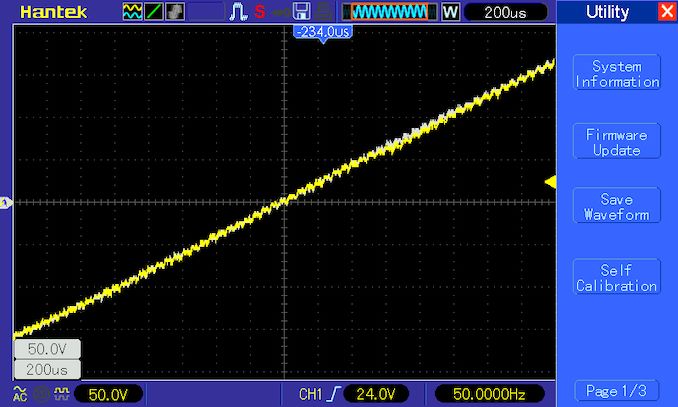
Blue line: Zero load / Yellow line: 1350 Watt load
The Vertiv Edge Lithium-Ion 1500 VA UPS also is exceptionally stable when the load suddenly shifts. The capture below reveals the worst output waveform deformation that we managed to cause while the unit was running on batteries and we had to immediately switch the load from zero to 100% in order to realize it - a completely unlikely real-world scenario.
Conclusion
Vertiv typically designs products for IT infrastructure and industrial sites. With the Edge Lithium-Ion 1500 VA UPS, Vertiv is trying to make a move towards the high-end retail market with a product that was initially designed for critical IT infrastructure, particularly for sites where frequent maintenance may difficult. Due to its intended design, we expected that its electrical performance would outclass more retail-grade products, and the Edge Lithium-Ion 1500 VA UPS did not let us down.
As far as consumer/household use is concerned, the UPS also fares very well there since it's dead-quiet while fully charged and running on AC power. The flip side to that, however, is that the fan can be loud when the UPS needs to charge its batteries. Although Vertiv’s engineers tried to implement a fan speed controller, the application was not brilliant, as the fan still operates at maximum speed most of the time. The saving grace here is the short battery charging time, meaning that the fan will not stay at maximum speed for several hours, as is the case with the vast majority of retail lead-acid UPS designs.
The highlight of this particular UPS obviously is the lithium-Ion battery. A VRLA battery of equal capacity would be almost twice as large and heavy, and as you might expect, Vertiv seems to be bringing that up a lot in their marketing brochures. But these are admittedly not significant advantages for stationary installations.
Rather, the two truly important advantages of using a lithium-Ion battery are its lifetime and charging current. The lithium-Ion battery will live for much longer than a typical VRLA battery and may even outlive the service life of the UPS itself, which is why Vertiv is so comfortable with offering a five-year warranty on the battery. It can also be charged much faster than VRLA batteries, with the Edge Lithium-Ion 1500 VA charging its battery from 10% to full in a little over two hours. This is very important in areas where the electricity supply is unreliable and the UPS needs to keep critical infrastructure, like a security system, communications equipment, or even a medical system, always running. If the load of the UPS is low, the Edge Lithium-Ion 1500 VA can keep equipment running even if the electrical grid is available for less than half of the day.
For the retail consumer, the advantages of owning a UPS like the Vertiv Edge Lithium-Ion 1500 VA are obvious. As the UPS was initially designed to protect critical infrastructure, it goes without saying that its electrical performance is outstanding, with exceptional transfer times and amazing output power quality. The lithium-Ion battery also offers rapid charging-discharging times and has a significantly greater lifetime than typical VRLA batteries. Undoubtedly, the Vertiv Edge Lithium-Ion 1500 VA is an excellent UPS by current standards, with fantastic overall performance and a lengthy warranty.
However, Vertiv is not a company with a strong retail presence, and as a result they seem to have difficulties truly bringing their products down to the high-end consumer market and making them available from more consumer-focused retailers. As such, not only is the retail price of the Edge Lithium-Ion 1500 VA unit well above $1.000 at the time of this review, but its retail availability is also limited, impairing the market potential of the unit. So while it's a fantastic UPS overall, given the high price tag, the only users we can really envision buying an Edge Lithium-Ion unit to begin with are those who need to protect very expensive equipment and/or have to deal with a very low-quality electrical grid. And, for better or worse, there are a number of other top-performance UPSes that are readily available from retailers even when the Edge is not.


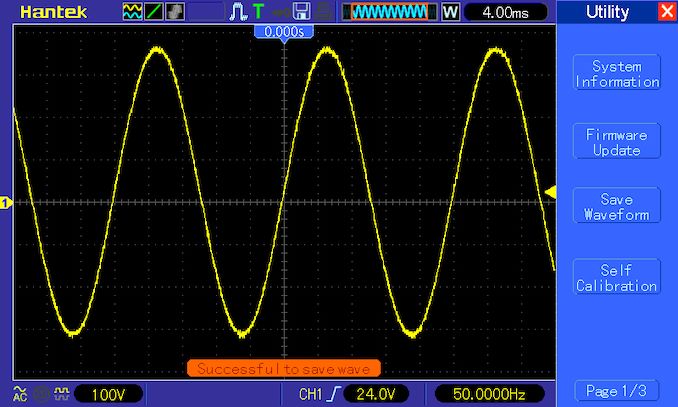

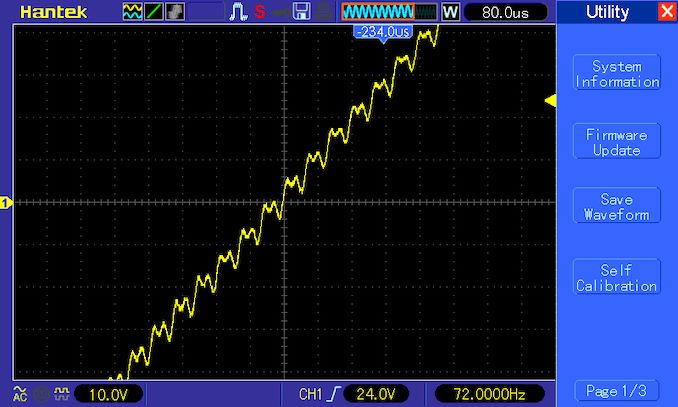
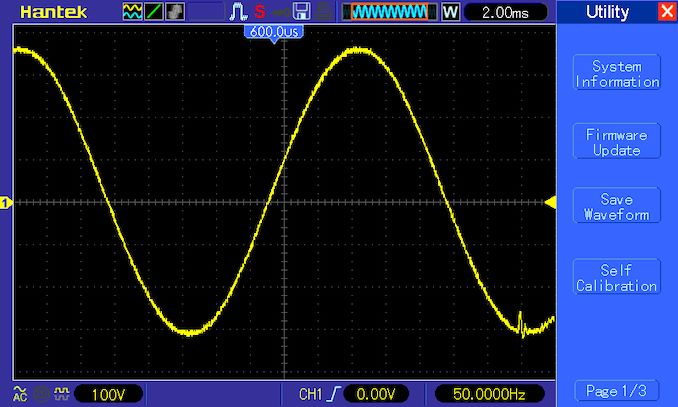
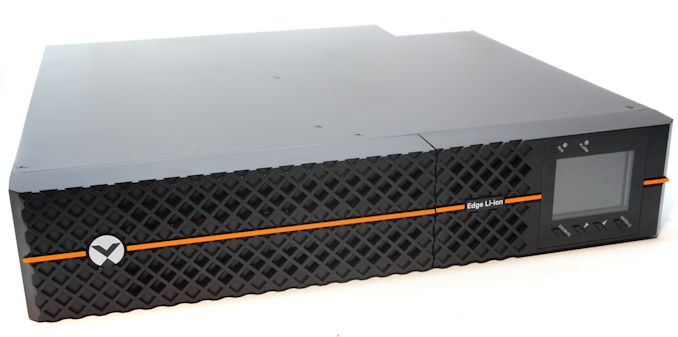
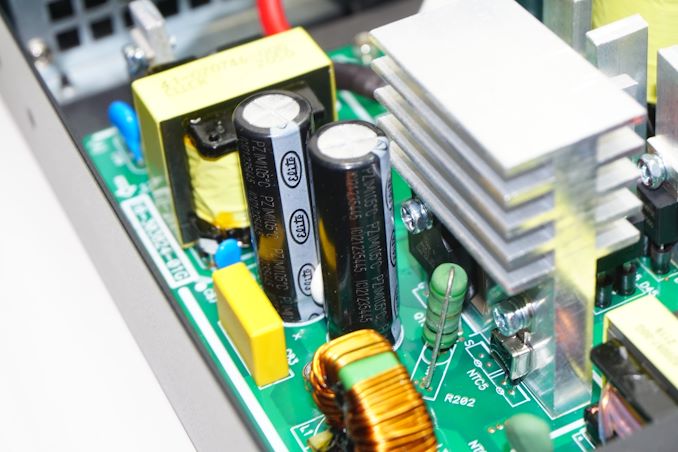
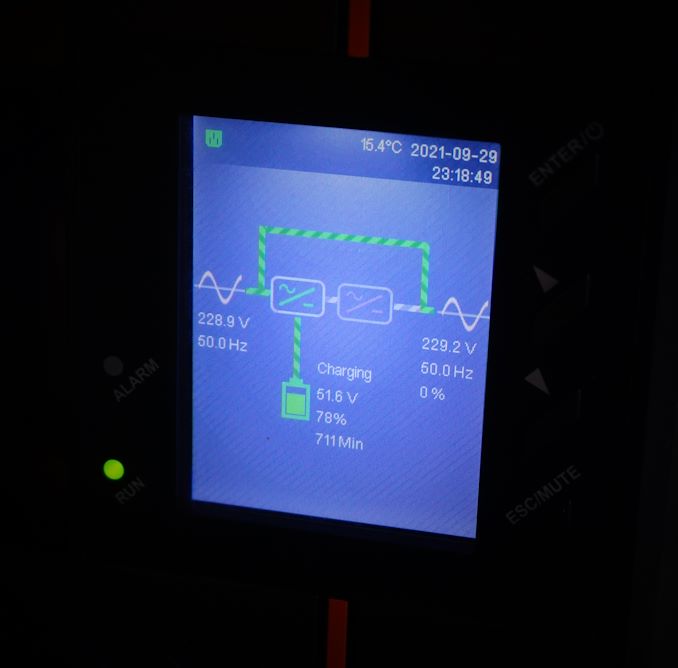








44 Comments
View All Comments
DanNeely - Monday, April 25, 2022 - link
Whatever they intended, as a rackmount model that's had some of the more enterprisy features stripped out of it I suspect it's main end user will end up being older SMBs who have a half-rack with a few on premise servers tucked away in a corner because they can't afford to migrate to the cloud and don't want to pay for fancy management features they don't know how to use.State of Affairs - Wednesday, April 27, 2022 - link
I agree. Moreover, I would think that the "enthusiast segment of the home/office PC market" would be more interested in the 120V version:https://www.vertiv.com/en-us/products-catalog/crit...
Samus - Monday, May 2, 2022 - link
I commented the same thing, and man we thought EGO had high profit margins. These $1000 UPS's with the same battery capacity make the damn lawn mowers look like a steal at $500.Lucky Stripes 99 - Thursday, June 16, 2022 - link
I thought the same thing. The maker of my electric mower sells a 60V 8.0 Ah li-ion battery and an 80V 5.0 Ah li-ion battery for $300 each. For the price, this UPS just doesn't wow me.TrevorH - Friday, April 22, 2022 - link
So batteries _might_ last 10 times as long as lead/acid ones which, if my experience with my APC is any guide, is usually about 3 years and averagely costs me anything from £40-£80. So are they really claiming a 30 year lifespan for this? And I didn't see any word about how much the replacement will cost - at today's prices, not in 30 years!Techie2 - Friday, April 22, 2022 - link
My experience with consumer based UPSs is that when they changed from true wattage output to VA things went down hill big time. The battery sizes as well as run times took a nosedive. The typical small lead-acid batteries supplied have a relatively short lifespan of 2-3 years because they are constructed more like an SLI battery than a true UPS style battery.An older APC UPS that I purchased had sufficient charging capacity for larger batteries so I added a couple of true UPS backup style batteries that provide a significant increase in run time and battery life of 8+ years. The battery construction is different on backup style batteries for commercial use in comparison to the small batteries supplied with a typical consumer UPS.
A consumer UPS is meant to provide a few minutes to shut down the PC or have software shut down the PC. These tiny batteries are not meant for meaningful run time when the grid power goes down. A good consumer UPS however will prevent a lot of PC or other sensitive electronics damage from brown-outs and line surges. For many people that could be worth the price of admission. I have found many very technically educated PC users and small Biz owners who refuse to spend the money for a simple, small UPS yet they complain constantly about corrupt or lost data from brown-outs and power surges.
Slash3 - Friday, April 22, 2022 - link
This looks like it's the product twin to the Voltronic Otima II RT 1.5K UPS.With Voltronic being a self described ODM for battery and solar, it sounds like they're the ones who produced this UPS. It's obviously been customized for Vertiv, but if you wanted to go down the component and assembly rabbit hole, looks like that's your source, with Vertiv being the retailer (and who provide their own sales and support for them, obviously).
https://voltronicpower.com/en-US/Product/Detail/Ot...
zanon - Saturday, April 23, 2022 - link
While I'm glad Anandtech is dipping its toes into the waters here, frankly your coverage also seems odd as does calling something like this a "high-end product". I run and do contracting for a number of SoHo/SMB settings with small racks, and I've spent a lot more money than this unit on UPS. I'm sure it has its niche, but at this price range I'd have a hard time in general justifying line-interactive vs double online topology. I'd also expect features like battery pack expansion and a decent network interface (with web gui, console and snmp/api options), neither of which this review mentions at all. Or take the battery modules, yes for sure LiON has a ton of advantages, will last longer etc. But what happens when it is time for replacement? 5 years is definitely not a point where a nice UPS would be replaced entirely. The online Cyberpower and APC units I've got support flat out hotswapping the batteries with no power interruption. Does this support bypasszanon - Saturday, April 23, 2022 - link
Shoot, accidentally hit submit. Was going to finish with does this support bypass modes and all that? You could argue that we should use an ATS for that kind of thing, but at $1000+ I think it should be a base level UPS feature too.But thanks again for reviewing these, the UPS market is ripe for some disruption and improvement and a comprehensive quality survey of what's going on would be great to see.
Sivar - Wednesday, April 27, 2022 - link
I appreciate the points you bring up that I and others may not have thought of, especially hot swapping the battery.